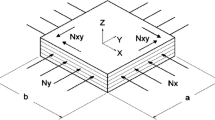The design of laminates with a minimum number of layers for obtaining the given elastic properties is addressed in the paper. The problem is treated and solved in the general case — no simplifying hypotheses are made about the type of their stacking sequence. The problem is stated as a nonlinear programming problem, where a unique objective function includes all the requirements to be satisfied by the solutions. The optimum solutions are found within the framework of the polar-genetic approach, since the objective function is written in terms of polar parameters of the laminates, while a nonclassical genetic algorithm is used as the optimization scheme. The optimization variables include the number of layers, layer orientations and layer thicknesses. In order to include the number of plies among the design variables, certain modifications of the genetic algorithm have been done, and new genetic operators have been developed. Some examples and numerical results concerning the design of laminates with a minimum number of layers for obtaining some prescribed elastic symmetries, bending-extension uncoupling, and quasi-homogeneity are shown in the paper.




















Similar content being viewed by others
References
H. Ghiasi, D. Pasini, and L. Lessard, “Optimum stacking sequence design of composite materials Part I: Constant stiffness design”, Composite Structures, 90, 1–11 (2009).
H. Ghiasi, K. Fayazbakhsh, D. Pasini, and L. Lessard, “Optimum stacking sequence design of composite materials Part II: Variable stiffness design”, Composite Structures, 93, 1–13 (2010).
A. Vincenti, P. Vannucci, and G. Verchery, “Design of composite laminates as an optimisation problem: a new genetic algorithm approach based on polar tensor invariants”, Proc. of WCSMO 5 (fifth world congress on structural and multidisciplinary optimisation), Lido di Jesolo, Venezia, Italy, (2003).
P. Vannucci, “Designing the elastic properties of laminates as an optimisation problem: a unified approach based on polar tensor invariants”, Structural and Multidisciplinary Optimisation, 31, No. 5, 378–387 (2006).
P. Vannucci and A. Vincenti, “The design of laminates with given thermal/hygral expansion coefficients: a general approach based upon the polar-genetic method”, Composite Structures, 79, 454–466 (2007).
A. Vincenti, P. Vannucci, and M. R. Ahmadian, “Optimization of laminated composites by using genetic algorithm and the polar description of plane anisotropy”, Mechanics of Advanced Materials and Structures, accepted for publication (2011).
F. Werren and C. B. Norris, “Mechanical properties of a laminate designed to be isotropic”, US Forest Products Laboratory, report 1841 (1953).
A. Vincenti, M. R. Ahmadian, and P. Vannucci, “BIANCA: a genetic algorithm to solve hard combinatorial optimisation problems in engineering”, Journal of Global Optimisation, 48, 399–421 (2010).
G. Verchery, “Les invariants des tenseurs d’ordre 4 du type de l’élasticité”, Proc. Of colloque Euromech 115, Villardde-Lans, France, (1979).
P. Vannucci, “Plane anisotropy by the polar method”, Meccanica, 40, 437–454 (2005).
R. M. Jones, Mechanics of Composite Materials, Taylor and Francis, USA (1975).
P. Vannucci, Thèse d’Habilitation à Diriger les Recherches, Université de Bourgogne, France, (2002).
P. Vannucci, “A special planar orthotropic material”, Journal of Elasticity, 67, 81–96 (2002).
A. Vincenti, G. Verchery, and P. Vannucci, “Anisotropy and symmetries for elastic properties of laminates reinforced by balanced fabrics”, Composites Part A, 32, 1525–1532 (2001).
E. Valot and P. Vannucci, “Some exact solutions for fully orthotropic laminates”, Composite Structures, 69, 157–166 (2005).
D. E. Goldberg, Genetic algorithms, Addison and Wesley, New York (1994).
Z. Michalewicz, Genetic algorithms + data structures = evolutionary programming, Springer, (1994).
A. Vincenti, Conception et optimisation de composites par mèthode polaire et algorithmes génétiques, PhD Thesis, Université de Bourgogne, France, (2002).
C. H. Park, W. I. Lee, W. S. Han, and A. Vautrin, “Multiconstraint optimisation of composite structures manufactured by resin transfer moulding process”, J. Composite Materials, 39, No. 4, 347–374 (2005).
S. W. Tsai and T. Hahn, Introduction to Composite Materials, Technomic, (1980).
K. A. De Jong, An Analysis of the Behaviour of a Class of Genetic Adaptive Systems, PhD Thesis, University of Michigan, USA (1976).
Aknowledgements
The first author was supported by the National Research Fund (FNR) in Luxembourg through Aides à la Formation Recherche Grant (PHD-09-139).
Author information
Authors and Affiliations
Corresponding author
Additional information
Russian translation published in Mekhanika Kompozitnykh Materialov, Vol. 48, No. 4, pp. 539-570, July-August, 2012.
Rights and permissions
About this article
Cite this article
Montemurro, M., Vincenti, A. & Vannucci, P. Design of the elastic properties of laminates with a minimum number of plies. Mech Compos Mater 48, 369–390 (2012). https://doi.org/10.1007/s11029-012-9284-4
Received:
Revised:
Published:
Issue Date:
DOI: https://doi.org/10.1007/s11029-012-9284-4




